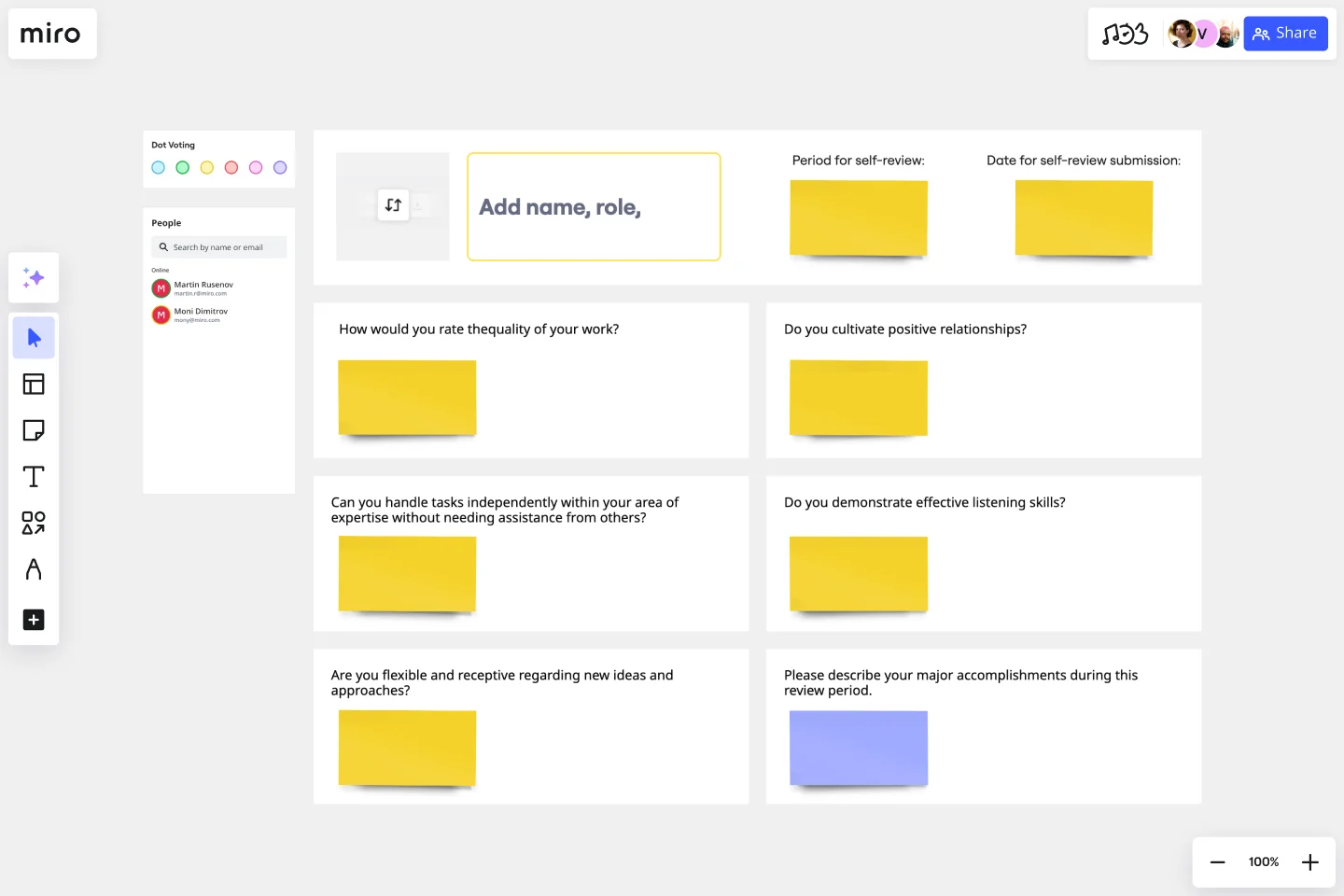Self-Evaluation Template
Use the Self-Evaluation Template to foster enhanced self-awareness. Dive deep into your professional performance, pinpoint strengths, and identify areas for improvement.
About the Self-Evaluation Template
Self-evaluation is an essential tool in the professional world as it allows people to reflect on their performance. It helps them identify their strengths and weaknesses and recognize areas that require improvement. The Self-Evaluation Template offers a concise and comprehensive framework for assessing one's contributions and interactions within an organization. This template can assist people in gaining a better understanding of their performance and setting goals for their professional development.
This template covers various elements to provide a comprehensive overview of the employee's performance. Let's explore its essential components:
Employee Info: A section dedicated to basic details such as the individual's name and the period the review covers. This ensures clarity and organization.
How would you rate the quality of your work? Here, employees can provide a rating or detailed feedback on the overall quality and consistency of their work.
Do you cultivate positive relationships? This area focuses on interpersonal skills and how the individual engages with colleagues.
Can you handle tasks independently within your area of expertise without needing assistance from others? This checks the employee's proficiency and confidence in their role.
Do you demonstrate effective listening skills? Communication is paramount, which assesses the employee's ability to listen and comprehend.
Are you flexible and receptive regarding new ideas and approaches? This measures adaptability, a key trait in the ever-evolving professional landscape.
Please describe your major accomplishments during this review period. A dedicated space for people to highlight their successes and milestones.
How to use the self-evaluation template
Begin by filling out the employee Info section for clarity.
Move systematically through each question, providing honest and thoughtful responses.
To edit, click on the desired section. With a few clicks, you can make any necessary changes.
If needed, the template is expandable, allowing for additional shapes and connector lines. Take advantage of automated diagramming features to keep everything structured.
You can also integrate other artifacts on the board to offer context or support to your evaluations.
Why should you use a self-evaluation template?
Objectivity: Provides a standardized format, reducing biases and promoting objective self-assessment.
Comprehensiveness: Ensures all key performance areas are reviewed, leaving no stone unturned.
Clarity: Helps people articulate their strengths and areas for improvement.
Enhanced Self-awareness: Enables professionals to gain insights into their own work behaviors and patterns.
Feedback Preparation: Prepares people for feedback sessions, making the discussions more productive and focused.
Can the template be customized?
Yes, while the base template covers essential areas, it can be tailored to fit specific organizational needs.
How frequently should I use this template?
Ideally, this should align with your organization's review cycle, whether that's quarterly, bi-annually, or annually.
Can I attach documents or links to support my responses?
Absolutely. The board allows for the integration of various artifacts to provide additional context.
Is this template suitable for all roles and industries?
While the template is designed to be versatile, it's always a good idea to ensure that the questions align with the specific role and industry nuances. Adjust as necessary.
Get started with this template right now.
Business Mindmap
Works best for:
Diagramming
The Business Mindmap template is a visual tool for brainstorming, organizing, and presenting business ideas and concepts. It provides a structured framework for capturing and connecting thoughts, insights, and action items. This template enables teams to explore business strategies, analyze market trends, and develop innovative solutions. By promoting creativity and collaboration, the Business Mindmap empowers teams to generate and communicate actionable business plans effectively.
PESTLE Analysis Template
Works best for:
Ideation, Strategic Planning, Business Management
Want to keep your company secure and performing soundly? You have to first know how you’ll be affected by outside elements and factors — especially those that are political, economic, social, technological, legal and environmental in nature. A PESTLE Analysis helps you identify them and prepare for them. With this easy-to-use template, you can conduct a PESTLE Analysis, then use the results to shape your strategic planning, budget allocation, marketing, product updates, and organizational change initiatives.
3 Horizons of Growth Template
Works best for:
Leadership, Strategic Planning, Project Planning
Featured in The Alchemy of Growth, this model gives ambitious companies a way to balance the present and the future—in other words, what’s working in the existing business and what emerging, possibly-profitable growth opportunities lie ahead. Then teams across the organization can make sure that their projects map to and support the organization’s goals. The 3 Horizons of Growth model is also a powerful way to foster a culture of innovation—one that values and depends on experimentation and iteration—and to identify opportunities for new business.
Team Charter Template
Works best for:
Meetings, Workshops, Team Meetings
A team charter is a document that outlines your team’s purpose and objectives, as well as steps you will take to reach your goals. The team charter illustrates the focus and direction for all team members. When created collaboratively, the team charter is a great way for individuals to feel even more connected to one another within the group. A team charter template is useful when you’re first establishing a new team, adding new members to an existing team, or when you need to better align regardless of your team’s tenure.
Three-Hour Brand Sprint Template
Works best for:
Marketing, Workshops, Sprint Planning
Before customers will believe in your brand, your team has to believe. That’s where brand sprints work wonders. Popularized by the team at Google Ventures, a brand sprint will help your team sort through all different ideas about your brand and align on your brand’s fundamental building blocks—your values, audience, personality, mission statement, roadmap, and more. Whether you’re building a new brand or revamping an existing one, brand sprints are ideal for trigger events such as naming your company, designing a logo, hiring an agency, or writing a manifesto.
